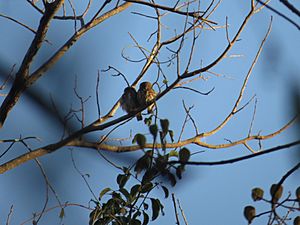Amazonian pygmy owl facts for kids
Quick facts for kids Amazonian pygmy owl |
|
|---|---|
 |
|
| Peru | |
| Conservation status | |
| Scientific classification | |
| Genus: |
Glaucidium
|
| Species: |
hardyi
|
 |
|
| Distribution of the Amazonian pygmy owl Resident | |
The Amazonian pygmy owl (Glaucidium hardyi) is a tiny owl. It lives in the northern parts of South America. You can also find it in the Amazon Basin. This owl is sometimes called Hardy’s pygmy owl. It belongs to the family of "true owls."
Contents
About This Owl
The Amazonian pygmy owl is part of the "true owl" family, called Strigidae. It belongs to a group of owls known as Glaucidium. These pygmy owls live in many places around the world.
For a long time, people thought the Amazonian pygmy owl was the same as the least pygmy owl. That was until 1989. New studies showed that the Amazonian pygmy owl was a different species. This meant the least pygmy owl only lived in certain forests in southeastern Brazil. Scientists keep studying these owls to learn more about their family tree.
What It Looks Like
Size and Appearance
The Amazonian pygmy owl is very small. Its name, "glaucidium," means "little owl." Adults have a large, round head. It has black spots that look like fake eyes on the back of its head. This might help scare away predators.
Its head is gray-brown with tiny white dots. Its tail and wing feathers are dark brown. They have three uneven bars of large white spots. The owl's belly is white. It has wide brown or reddish-brown stripes.
These owls are about 14–15 cm (5.5–6 inches) long. They usually weigh around 60 grams (2 ounces). Male and female owls look exactly the same. This is called "no sexual dimorphism." Young owls look like adults. But their heads do not have spots. Their belly stripes are also less clear.
They have bright golden-yellow eyes. Their beak is greenish-yellow. Their feet have two toes pointing forward and two pointing backward. This helps them grip branches and prey.
Calls
The main call of the Amazonian pygmy owl is a repeated sound. It is short, high-pitched, and sounds like "tweets."
Where It Lives
Distribution
The Amazonian pygmy owl lives in the central and southwestern parts of the Amazonia region. Scientists have seen it in northern Bolivia. It also lives in Peru, both in and north of the Amazon. Its home range goes east to eastern Venezuela, Guyana, Suriname, and French Guiana.
Habitat
This owl lives in the top layers of tall, humid, tropical evergreen forests. These layers are called the canopy and subcanopy. They have been seen from lowlands up to over 1100 meters (3,600 feet) high.
How It Behaves
Diet
We do not know much about what these owls eat. They probably hunt large insects like cicadas. They also likely eat small animals with backbones, like tiny birds or lizards.
Behavior
The Amazonian pygmy owl is active during the day. This is called being "diurnal." They often sit quietly in one spot for a long time. Because of this, it is hard to spot them even during the day. Observations suggest that they stay with one partner for life. This is known as being "socially monogamous."
Nesting
Only one nest of an Amazonian pygmy owl has been written about. It was found in French Guiana. The owls used a hole that a woodpecker had made. Two adult owls were at the nest. One adult always stayed close to the nest. The other adult would leave for short times to find food. This shows that they take great care of their young.
Scientists saw the adults bring a large cicada and a small bird to the nest. They fed these to their young. On hot days, the adults would pant with their beaks partly open. They also often sang a soft, high-pitched, trilling song that went down in notes.
Ecology
The Amazonian pygmy owl is a common predator in the northern Amazon basin. Sometimes, smaller animals will gang up on the owl to chase it away. This is called "mobbing behavior." It is a way for prey animals to protect themselves.
Protecting This Owl
The IUCN lists the Amazonian pygmy owl as "Least Concern." This means it is not currently in danger of disappearing. This is because it lives across a very large area. However, the IUCN also says that the number of these owls is going down. We do not know exactly how many owls there are.
Research shows that parts of the Amazon basin are losing their forest canopy. This is due to selective logging. Since the Amazonian pygmy owl lives in the forest canopy, these changes likely affect them. Protecting their forest home is important for their future.
See also
 In Spanish: Mochuelo amazónico para niños
In Spanish: Mochuelo amazónico para niños



